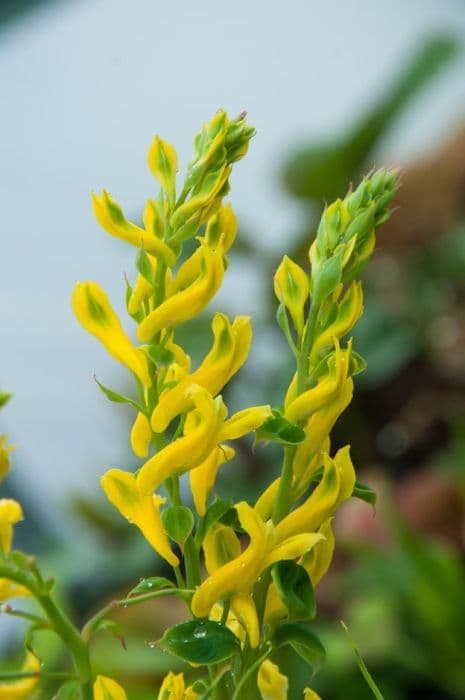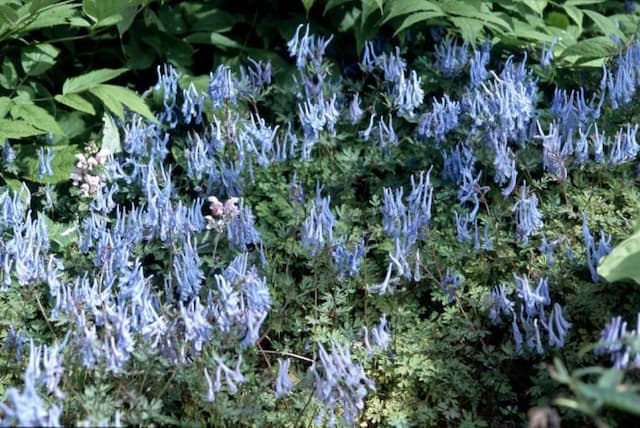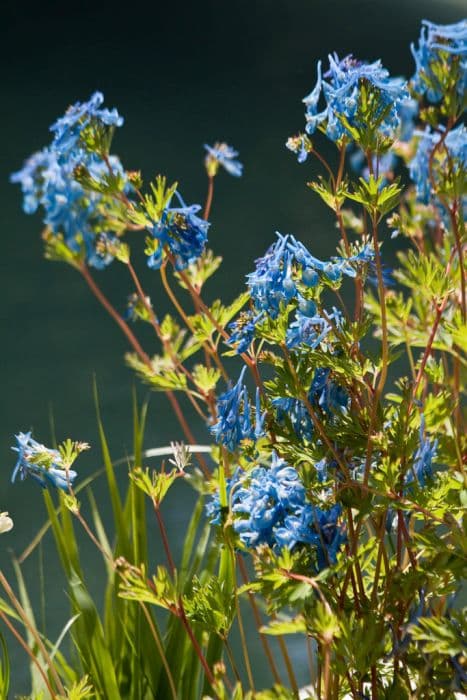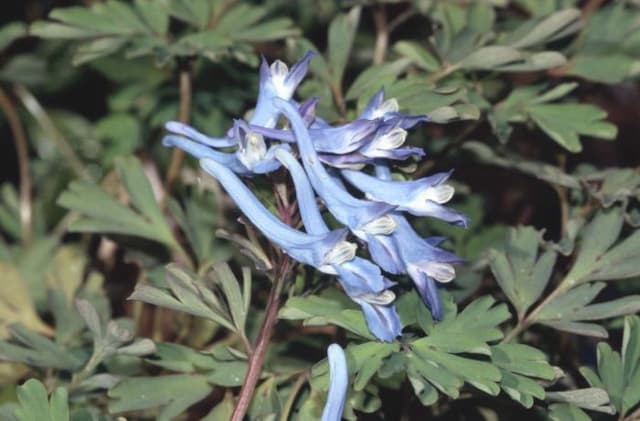Papaver (Oriental Group) 'Leuchtfeuer'

ABOUT
Papaver 'Leuchtfeuer', commonly known as Oriental poppy, is a perennial plant that is prized for its striking appearance. The plant features large, bowl-shaped flowers that are vivid in color, with 'Leuchtfeuer' being characterized by its fiery red petals. These petals have a silky sheen and a delicate, tissue-paper-like texture, making the blooms quite eye-catching when they appear in late spring or early summer. One of the most distinctive aspects of Oriental poppy flowers is their dark basal blotches, which form a dramatic contrast with the bright red petals. The center of each flower is dominated by a velvety black cross formed by the stamens, this adds a striking feature to the already vibrant bloom. The foliage of the Oriental poppy 'Leuchtfeuer' is equally noteworthy. The leaves are deeply divided, giving them a feathery appearance, and they have a slightly coarse texture. The color of the foliage is a lush green, providing a perfect backdrop for the splash of color brought by the flowers. As a perennial, the Oriental poppy 'Leuchtfeuer' will die back after flowering but can be expected to return the following season with its glorious display, making it a popular choice for gardeners wishing to add drama and vivid hues to their borders or flower beds. The plant enjoys full sun and tends to thrive in well-drained soil, adding beauty to any garden landscape without the need for excessive care.
About this plant
 Names
NamesFamily
Papaveraceae
Synonyms
Oriental Poppy, Perennial Poppy
Common names
Papaver orientale 'Leuchtfeuer'
 Toxicity
ToxicityTo humans
The Oriental poppy is considered mildly toxic if ingested. While the toxicity level is generally low, consuming any part of the plant can potentially cause stomach upset, vomiting, or sedation in humans.
To pets
Similarly to humans, the Oriental poppy is mildly toxic to pets. If ingested, pets may experience symptoms such as stomach discomfort, vomiting, and drowsiness. It is advisable to prevent pets from consuming any part of this plant to avoid these potential adverse effects.
 Characteristics
CharacteristicsLife cycle
Perennials
Foliage type
Deciduous
Color of leaves
Green
Flower color
Red
Height
2-3 feet (60-90 cm)
Spread
1-2 feet (30-60 cm)
Plant type
Herb
Hardiness zones
3-7
Native area
Caucasus
Benefits
 General Benefits
General Benefits- Aesthetic Appeal: Oriental Poppy 'Leuchtfeuer' is known for its striking, large, bright red flowers which add vivid color and visual interest to any garden.
- Attracts Pollinators: The showy blooms of the Oriental Poppy attract bees, butterflies, and other beneficial pollinators, supporting local ecosystems.
- Drought Tolerance: Once established, it is relatively drought-tolerant, which makes it suitable for xeriscaping or gardens with low water availability.
- Low Maintenance: This perennial plant is generally low-maintenance, requiring minimal care once it is settled in the appropriate growing conditions.
- Cold Hardy: It is capable of surviving in colder climates, making it a resilient choice for gardens in a variety of geographic areas.
- Deer Resistant: Oriental Poppies are typically resistant to deer, which helps prevent them from being eaten in areas where deer are a common problem.
- Seasonal Interest: In addition to its spring bloom, the plant provides interesting foliage and seed pods that offer visual interest even after flowers have faded.
- Easy to Propagate: It can be easily propagated from seeds or division, allowing gardeners to expand their display or share with others.
- Herbaceous Perennial: As a herbaceous perennial, the plant dies back in the winter and returns each spring, reducing the need for yearly planting.
 Medical Properties
Medical PropertiesThis plant is not used for medical purposes.
 Air-purifying Qualities
Air-purifying QualitiesThis plant is not specifically known for air purifying qualities.
 Other Uses
Other Uses- The seed pods of the Oriental poppy can be used in dried floral arrangements, providing a unique, architectural element to the design.
- Oriental poppy petals are sometimes used in the creation of natural dyes for fabrics, offering hues ranging from pale pinks to deep reds.
- The flowering plant can serve as a vibrant photographic subject for artists and photographers, capturing its bold colors and delicate textures.
- Gardeners may use the distinct foliage of the Oriental poppy as a contrasting background to highlight other plants in a garden bed.
- The plant can act as a living mulch, as its dense growth in the spring can suppress weeds around the planting area.
- Ecologically, Oriental poppies provide nectar for pollinators, such as bees, helping to support local ecosystems.
- During winter, when the plant is dormant, its distinctive seed heads can add visual interest to the otherwise barren landscape.
- Plant enthusiasts may collect the seeds of the Oriental poppy for seed swaps, sharing the beauty of this plant with others.
- Children can use the fallen petals for creative play, such as making poppy fairy skirts or decorating hand-crafted greeting cards.
- Oriental poppy plants can serve as a natural indicator of soil health, thriving in well-draining areas and indicating potential issues in waterlogged soils.
Interesting Facts
 Feng Shui
Feng ShuiThe Oriental poppy is not used in Feng Shui practice.
 Zodiac Sign Compitability
Zodiac Sign CompitabilityThe Oriental poppy is not used in astrology practice.
 Plant Symbolism
Plant Symbolism- Rest: Poppies are often associated with rest and sleep due to the sedative effects of opium, extracted from some poppy species.
- Peace: The poppy is a symbol of peace often used to commemorate soldiers who have died during wartime, especially in relation to World War I.
- Remembrance: Poppies are worn and displayed to remember the fallen soldiers, especially on Remembrance Day due to the famous poem “In Flanders Fields.”
- Resilience: Poppies can grow in harsh conditions, symbolizing the resilience and the ability to endure difficulties.
- Beauty and Extravagance: The bright and showy flowers of the poppy represent beauty in life, reminding people to appreciate the aesthetics around them.
 Water
WaterThe Oriental poppy 'Leuchtfeuer' prefers somewhat dry conditions and should be watered infrequently, especially once established. Overwatering can lead to root rot, so ensure the soil is well-draining and allow the soil to dry out somewhat between waterings. It is generally adequate to provide the plant with about 1 inch of water weekly, but this can vary depending on climate conditions. During periods of drought or extreme heat, you may need to water twice a week, ensuring you provide deep watering to encourage root growth. In cooler weather or when rainfall is sufficient, reduce watering accordingly.
 Light
LightOriental poppies, including the 'Leuchtfeuer' variety, thrive in full sun conditions. They require a minimum of 6 hours of direct sunlight daily to ensure healthy growth and abundant flowering. The best spot for planting is an area that receives early morning sunlight, which is less harsh than the intense afternoon sun, although they can still perform well in the latter if acclimatized. Avoid planting in deep shade, as this will significantly impair flowering and can cause leggy growth.
 Temperature
TemperatureOriental poppies 'Leuchtfeuer' are hardy plants that can withstand a wide range of temperatures but thrive in conditions between 60°F and 75°F. These plants can tolerate winter cold down to about -30°F once they are dormant and exhibit good heat tolerance in summer, as long as they are not subjected to excessive humidity. It's best to plant them in a location that protects them from extreme heat, which could stress the plant, especially during the hottest part of the day.
 Pruning
PruningPruning Oriental poppies like 'Leuchtfeuer' is primarily done to remove spent flowers and encourage a potential second bloom. After the initial flowering, cut back the flower stalks to the base of the plant. Minimal pruning is required otherwise; however, in the fall, you can cut back the foliage after it has died back naturally. This helps to tidy the plant and prepare it for winter dormancy. There is no need for regular shaping or pruning outside of these instances.
 Cleaning
CleaningAs needed
 Soil
SoilOriental Poppy 'Leuchtfeuer' thrives in well-draining soil with a neutral to slightly acidic pH, ideally between 6.5 and 7.0. A soil mix composed of garden loam, compost, and sharp sand can ensure good drainage and fertility. Adequate organic matter is important for both nutrients and moisture retention while avoiding waterlogged conditions which can lead to root rot.
 Repotting
RepottingOriental Poppies 'Leuchtfeuer' are perennial plants that do not generally require frequent repotting. They have a deep taproot system making them difficult to transplant. Repotting is usually not necessary unless the plant is outgrowing its space; instead, renewal through division every few years in autumn is recommended.
 Humidity & Misting
Humidity & MistingOriental Poppy 'Leuchtfeuer' is tolerant of a wide range of humidity levels and does not require any specific humidity conditions to thrive. They are well-adapted to outdoor conditions where the humidity is dictated by natural weather patterns.
 Suitable locations
Suitable locationsIndoor
Ensure full sun and well-draining soil for indoor growth.
Outdoor
Full sun, well-draining soil, and protection from strong winds.
Hardiness zone
3-7 USDA
 Life cycle
Life cyclePapaver (Oriental Group) 'Leuchtfeuer', also known as Oriental poppy 'Leuchtfeuer', starts its life as a seed that germinates in the cool temperatures of early spring. Once the seedling emerges, the plant develops a rosette of fuzzy, deeply lobed leaves. As the weather warms, a flower stalk grows, and the plant produces large, showy red flowers with black markings at the base of the petals, typically blooming in late spring to early summer. After pollination, which is often assisted by bees and other insects, the flowers fade to give way to seed pods that release numerous tiny seeds when mature. The plant then enters a period of dormancy during the hot summer months, where the foliage dies back, and it may seem as though the plant has died. It overwinters as a rootstock and regrows from this rootstock in the following spring, completing its perennial cycle.
 Propogation
PropogationPropogation time
Early spring
The most popular method of propagation for the Oriental Poppy 'Leuchtfeuer' is through seed collection and sowing. Mature pods from spent flower stems are collected in late summer once they turn brown and start to crack open. The tiny, pepper-like seeds inside the pod are then harvested and can be sown immediately in the soil where they are to grow, or stored in a cool, dry place until the following spring. Sowing should take place in well-draining soil, lightly covered with a layer of soil about 1/8 inch (about 3 millimeters) thick. Seedlings usually appear in 14-28 days depending on temperature and conditions. This method is often favored as it preserves the genetic diversity of the plants, allowing for some variation in the offspring, and it is simple enough for even novice gardeners to attempt.









